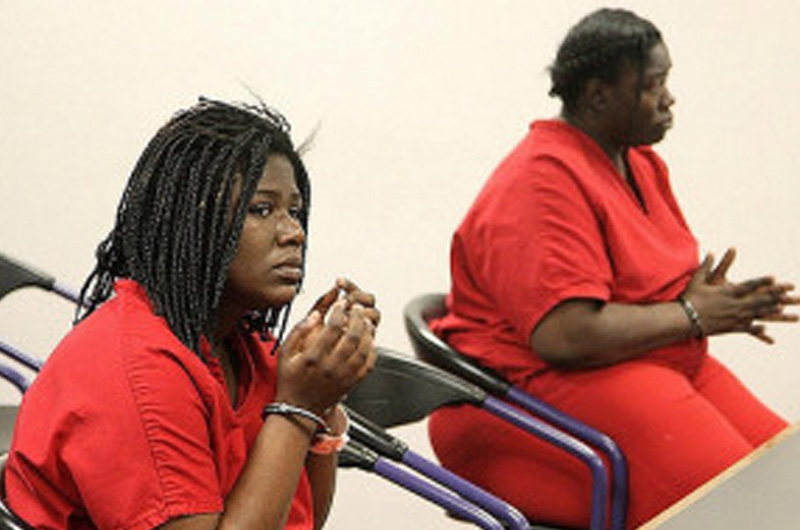Michelle Alexander¬Ýaddressed an issue that remains a problem within the African-American community, in theThe New Jim Crow¬Ýpublished in 2010.
She found that,¬Ý‚Äúthere are more African-Americans under correctional control ‚Äî in prison or jail, on probation or parole ‚Äî than were enslaved in 1850, a decade before the Civil War began.‚Äù
Due to the fact that¬ÝAfrican-American¬ÝNews & Issues, is a publication that thrives off of reporting current and historical realities affecting our communities; we thought that it was necessary to address an existent and growing problem in society. The rate of female African-American incarceration is at an all-time rise. This variable is vital to the community because, women are the mothers of the future. So there arises a problem not only in a home but in the community, when the presence of mothers are absent.
According to, the¬ÝSentencing Project Research and Advocacy for Reform,¬Ý‚Äú28% of mothers report that their children live with their fathers while they are incarcerated; nine out of ten mothers report that their children live with a grandparent, other relative, or a friend of the mother; 10% of women have children living in a foster home or agencyand women in prison are five times more likely than men to report having children removed from their immediate families and placed in a foster home or other agency.‚Äù¬ÝFactors such as these further contribute to the break down of family structure within the African-American community and culture.
African-American Female Incarceration Rate
Just four years ago, the¬ÝBureau of Justice Statistics¬Ýconcluded that the female inmate population was an estimated 1.6 million. Of that total nearly 23 percent of that sum represents the African-American female population. According to these numbers, African-American women show a rate that is six times higher when compared to White women, in terms of incarceration. Based off of the determination of the findings in 2011, a dramatic increase has been noted amongst Black female incarceration rates; that is when compared to findings reported in 2005.
According to the¬ÝSentencing Project Research and Advocacy for Reform, African-American women were,¬Ý‚Äúthree times more likely than White women to be jailed or imprisoned.‚ÄùTherefore, if one was to take into account the conclusion from the statistics of these reports and studies, it is clearly evident that the female African-American incarceration rate has doubled within a matter of seven years. This is a devastating reality as it relates to the Black community.
Adjusting to the Free Society
When considering women who are incarcerated there are a variety of factors to think on. Just as there are many ills that people associate with males who have been in prison, women deal with a wide range of elements as well. Just to list a few: sexual assault, mental and physical issues, as well as family and socioeconomic problems are all limbs that extend from the branch of imprisonment, and that is just to state the least.
Sexual assault has been reported as a major problem amongst female inmates within prisons. Health issues and sexually transmitted diseases is another ailment that can often result, due to sexual assaults. These ills have a tendency to cause female prisoners to suffer with mental and emotional stability once released from imprisonment. Thereby, causing another disadvantage in regards to them being able to effectively adjust and become a productive citizen.
Another factor that should be considered is the fact that former inmates are already marked with a brand. One study proposes that,¬Ý‚ÄúWithin three years of being released, 67% of ex-prisoners re-offend and 52% are re-incarcerated.‚Äù¬ÝA contributing factor to this rate is because once female prisoners are released they have very little resources available to them. Oftentimes, these women are not eligible for welfare or subsidized housing and not to mention employment. Finding a job is a problem that many face simply because they have a criminal record. With these odds against them it has a tendency to result in many of them returning to the only lifestyle they know, which often leads to re-imprisonment.
This is an element that should be looked at because these ex-offenders are not just strangers; they are our mothers, aunts, sisters, cousins and other loved ones. Therefore, implementing programs and creating institutions that will serve to allow them the capability and knowledge needed to adjust to society should be a consideration for leaders within the community. Counseling for these individuals and their families is another option that could help reduce the ratio of returning ex-offenders.
With the increase of female incarceration in the African-American community, measures should be taken to educate the current generations about the hardship that imprisonment can place on a family. Parents, educators and leaders of the African-American community have a duty to ensure that problematic areas within its race are identified; so that the youth are made aware of potential hazards that they face. Research has shown in times past that there has been a great impact in the lives of the children whose parents were incarcerated during their childhood. In some cases, children of these families develop and lead a life of destruction which ultimately translates into imprisonment for them as well.
Noticeable Disparities between Races
Understanding the root of the problem is crucial in reference to the female incarceration rate within the Black community. Accordingly, research shows that, drugs and violent offenses remain two of the most common charges that African-American women are prosecuted and imprisoned for. Drug offenses have been attributed as being over half of the reason for female African-American incarceration, in recent years.¬ÝThe Sentencing Project Research and Advocacy for Reform¬Ýindicated telling racial disparities in comparison to drug offenders.
Its studies showed that, about 14 million Whites and 2.6 million African- Americans have reported using an illicit drug. However,¬Ý‚Äúfive times as many Whites are using drugs as African-Americans, yet African-Americans are sent to prison for drug offenses at 10 times the rate of Whites.‚Äù
Additionally the Sentencing Project revealed that,¬Ý‚ÄúAfrican-Americans represent 12% of the total population of drug users, but 38% of those arrested for drug offenses, and 59% of those in state prison for a drug offense; and African-Americans serve virtually as much time in prison for a drug offense (58.7 months) as whites do for a violent offense (61.7 months).‚Äù
Concluding,¬ÝNetflix¬Ýhas released a series that has given the world a look into the life of incarcerated women.¬Ý‚ÄúOrange is the New Black‚Äù¬Ýis a show that demonstrates the inner scenes behind prison walls. The series is birthed out of the concept of an inmate‚Äôs memoirs. It gives an account of¬ÝPiper Kerman‚Äôs 15-month sentence to a federal women‚Äôs prison and the different experiences encountered while confined.
The role is played by a character named¬ÝPiper Chapman¬Ýwho is a resident of New York City. The series exemplifies real life situations that occur in prisons throughout the nation. The show has caused people around the nation to have a different view of the way that female inmates are treated within the criminal justice system.
Thus, members of the Black community would be wise to pay attention to this trend that has become an epidemic within the Black race. After all, imprisoned females are not strangers and neither are the children they leave behind or birth while imprisoned.









